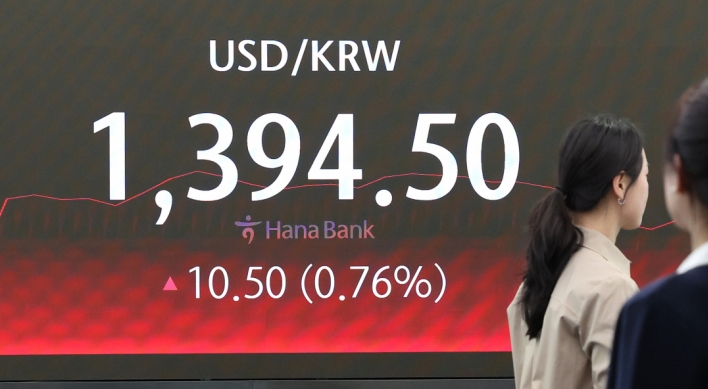Korea has highest reliance on private education market in OECD: report
By Yoon Min-sikPublished : Sept. 10, 2014 - 21:17
Despite governmental efforts to boost spending on public education ― including ongoing efforts to cut college tuition ― Korean parents are still burdened with the hefty price of children’s learning, a new report by the Organization for Economic Co-operation and Development has found.
In South Korea, 37.2 percent of the funding for educational institutes came from the private sector, which was the highest of all OECD countries and more than double the OECD average of 16.1 percent. This was in stark contrast to Sweden and Finland, whose governments paid for 97 percent of the costs of education.
Andreas Schleicher, director of education at the OECD, said placing a heavy burden of education on the private sector is a “chronic trend” among East Asian countries.
Much of the hefty education fees were racked up by tertiary education. On average, 31 percent of the financial burden for higher education fell on the private sector among OECD countries.
It was the other way around in South Korea, with parents and families paying for 73 percent of the fees.
The country was followed by neighbor Japan in both the percentage of private spending in public education and private contribution to tertiary education, with 30.5 percent and 65.5 percent, respectively.
Overall, South Korea spent 4.9 percent of its GDP on public education, 0.4 percent lower than the OECD average of 5.3 percent. While OECD countries spend on average $9,487 per student annually, South Korea spent $8,382.
South Korea had among the highest number of students per class, with 25.2 in elementary schools and 33.4 in middle schools. The numbers far surpassed the OECD average of 21.3 and 23.5, respectively, and South Korean middle schools had the most crowded classrooms among all members.
In addition, the report showed that the recent economic process did little to slow the expansion of access to education.
But it did show that people with lower education levels have been hit proportionately harder by the rise in unemployment that battered countries during the economic crisis.
Across the 34 OECD advanced economies, the unemployment rate for people with a university education stood at 5.0 percent, with 7.4 percent for people aged 25-34. The unemployment rate for 25-34 year-olds without an upper secondary education reached 19.8 percent in 2012, the report said.
There is also evidence of a “widening gap between the educational ‘haves’ and ‘have-nots,’” Angel Gurria, secretary-general of the OECD, noted, with a yawning gap in earnings between those who hold a university education and those who left school at 16.
By Yoon Min-sik and news reports
(minsikyoon@heraldcorp.com)
In South Korea, 37.2 percent of the funding for educational institutes came from the private sector, which was the highest of all OECD countries and more than double the OECD average of 16.1 percent. This was in stark contrast to Sweden and Finland, whose governments paid for 97 percent of the costs of education.
Andreas Schleicher, director of education at the OECD, said placing a heavy burden of education on the private sector is a “chronic trend” among East Asian countries.
Much of the hefty education fees were racked up by tertiary education. On average, 31 percent of the financial burden for higher education fell on the private sector among OECD countries.
It was the other way around in South Korea, with parents and families paying for 73 percent of the fees.
The country was followed by neighbor Japan in both the percentage of private spending in public education and private contribution to tertiary education, with 30.5 percent and 65.5 percent, respectively.
Overall, South Korea spent 4.9 percent of its GDP on public education, 0.4 percent lower than the OECD average of 5.3 percent. While OECD countries spend on average $9,487 per student annually, South Korea spent $8,382.
South Korea had among the highest number of students per class, with 25.2 in elementary schools and 33.4 in middle schools. The numbers far surpassed the OECD average of 21.3 and 23.5, respectively, and South Korean middle schools had the most crowded classrooms among all members.
In addition, the report showed that the recent economic process did little to slow the expansion of access to education.
But it did show that people with lower education levels have been hit proportionately harder by the rise in unemployment that battered countries during the economic crisis.
Across the 34 OECD advanced economies, the unemployment rate for people with a university education stood at 5.0 percent, with 7.4 percent for people aged 25-34. The unemployment rate for 25-34 year-olds without an upper secondary education reached 19.8 percent in 2012, the report said.
There is also evidence of a “widening gap between the educational ‘haves’ and ‘have-nots,’” Angel Gurria, secretary-general of the OECD, noted, with a yawning gap in earnings between those who hold a university education and those who left school at 16.
By Yoon Min-sik and news reports
(minsikyoon@heraldcorp.com)







![[KH Explains] How should Korea adjust its trade defenses against Chinese EVs?](http://res.heraldm.com/phpwas/restmb_idxmake.php?idx=644&simg=/content/image/2024/04/15/20240415050562_0.jpg&u=20240415144419)











![[Today’s K-pop] Stray Kids to return soon: report](http://res.heraldm.com/phpwas/restmb_idxmake.php?idx=642&simg=/content/image/2024/04/16/20240416050713_0.jpg&u=)